| Notes: The Midland Railways London Extension into St. Pancras was ready for inspection in July 1868 but the Board of Trade inspector refused to sanction the opening of St. Pancras because the approaches to the station were, at that time unfinished. The inspector was however happy with the rest of the line and agreed to the opening of the line between Bedford and Camden |
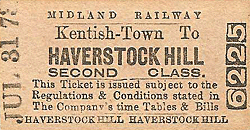 |
Town where there was a junction that allowed trains to run into the Metropolitan Line's station at Moorgate Street. The line was opened between Bedford and Moorgate street on 13th July 1868 with intermediate stations with the London area at Hendon, Finchley Road & St Johns Wood, Haverstock Hill, Kentish Town and Camden Road. Work on the approaches to St. Pancras continued and the station finally opened on 1st October 1868.
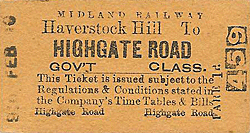 |
Haverstock Hill station was located in a cutting with tall retaining walls between Belsize Tunnel and Lismore Tunnel with its brick irregularly shaped and ornamental street level building facing onto Lismore Circus. Two decades earlier, a residential scheme had been planned, which envisaged rows of large semi-detached houses, radiating outwards from Lismore Circus. This |
would be the hub of the development and feature a garden as its centre piece. Very little work was undertaken however and the planned garden became an unkempt piece of muddy wasteland. The radiating roads also failed to live up to expectations. Despite this lack of the planned development of the area the Midland Railway felt that the scheme might still go ahead and provided a station building in keeping with the proposed development.
The building incorporated the ticket office along with waiting rooms and ladies and gents toilet. From the building there was a covered way from which stairs descended to the two platforms which were protected from the elements by awnings fitted on metal girders which stretched from one side of the formation to the other. These girders extended over both passenger and goods lines and were supported almost centrally by a row of iron columns along the rear of the down platform.
| Haverstock Hill signalbox was sited towards the western end of the down platform and replaced an earlier cabin in 1882. Following the construction of the second Belsize Tunnel in 1884 both pairs of tracks were realigned through Haverstock Hill station which resulted in the reconstruction of the platforms on different alignments, although the street level building |
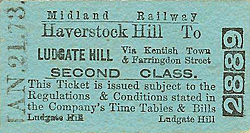 |
remained on its original site. A new up platform was provided and the old down platform was widened and lengthened; there were also alterations to the stairs. The original girders and awnings were also removed at this time and replaced by conventional platform canopies supported by iron columns.
Passenger traffic at Haverstock Hill with initially quite healthy with 179,837 tickets issued in 1872 but the station was unable to compete with improved road transport in inner London in the early 20th century and by 1915 ticket sales had plummeted to 18,462 and the station was closed on 1st January 1916.
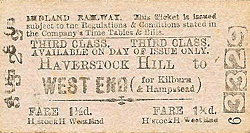 |
The platform canopies were demolished shortly after closure but the platforms remained standing for many years. The signal box remained in use but eventually closed on 20th October 1946. During the 1950s the street level building was occupied by an engineering firm and was known as 'Station Works' and during the 1960s it was occupied by company producing |
accessories for motor cycles and scooters, which traded there until 1967. The building then fell into complete disuse and is understood to have suffered fire damage before it was demolished c.1969.
| At track level the platforms remained and were demolished piecemeal through the 1970's and 80s being substantially cut back during electrification of the line to Bedford in 1982. With the reopening of Snow Hill tunnel and the introduction of a new cross-London service local newspapers reported a proposal to reopen the station in the summer of 1985 but this came |
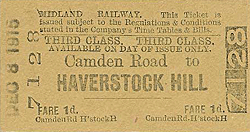 |
to nothing and was soon forgotten.
Today some degraded sections of the platforms remain while at street level the area has been substantially developed with new housing. A section of the back wall of the station building still survives as a bridge parapet in the now pedestrianised Lismore Circus.
Sources:London's Disused Stations Volume 7 The Midland Railway by J E Connor. Published 2009 by Connor & Butler. ISBN 978 0 947699 42 2
For more pictures of Haverstock Hill station see Abandoned Tube Stations web site
Ticket from Michael Stewart, timetable from Glynn Waite, route map drawn by Alan Young
For other Midland Railway London suburban stations click on the station name: Hendon Factory Platform, Welsh Harp, Finchley Road, Camden Road,
Dudding Hill & Harlesden for West Willesden & Stonebridge Park |

old1.jpg)

12.jpg)
1.jpg)
4.jpg)
7.jpg)
10.jpg)
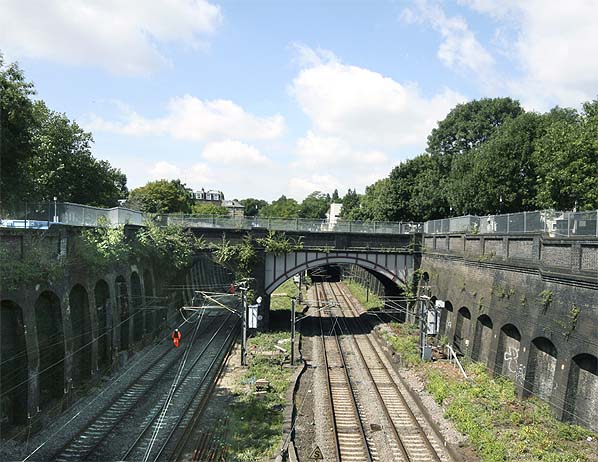














hill_thumb16.jpg)



 Home Page
Home Page